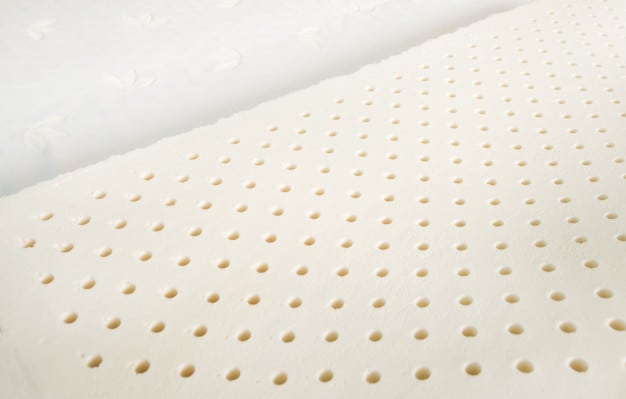16 Tips to Prevent Your Latex Mattress From Sagging
Have you ever had trouble sleeping on your latex mattress because it is sagging? Latex mattresses are known for being durable, but they will eventually start to sag if not properly taken care of. The good news is that there are many ways you can prevent a latex mattress from sagging and prolonging its lifespan.
In this article, we'll be discussing why a latex mattress may sag, what factors contribute to the risk of sagging, and how these tips can help keep your natural latex bed in top shape!
Disclaimer: As an Amazon Associate I earn from qualifying purchases.
So How Do I Stop My Latex Mattress from Sagging?
1. Choose Natural Latex over Synthetic Latex
Synthetic latex is made of synthetic polymers and other manmade materials, which will not hold up for as long. Synthetic latex mattresses are also more prone to sagging because they cannot adjust or adapt to your bodyweight like natural latex can.
These types of mattresses contain high levels of fillers like China Clay, calcium oxide, or titanium dioxide, which can make the material less durable and more likely to sag.
These fillers also reduce the antibacterial and antimicrobial properties of the mattress, making it more vulnerable to mold and bacteria overgrowth, which can cause the mattress to break up much faster.
Read More: What Are the Pros and Cons of Organic Latex?
2. Choose Dunlop Latex over Talalay Latex
Dunlop latex mattresses are made of unprocessed rubber, and Talalay is created by processing the material. The main difference between them comes down to durability.
Dunlop latex lasts longer because it is less processed and it's also denser than Talalay, which is one of the reasons it lasts longer.

3. Choose a Latex Mattress with Spring Support
Hybrid latex mattresses are much less prone to sagging because they have springs inside of them which make the mattress much more responsive. Choose mattresses with individually wrapped could, which help distribute your weight more evenly across the mattress, preventing it from sagging over time.
For even better support, pick a mattress with zoned support coils, this type of innerspring system provides more support to key areas around your hips and shoulders, further improving comfort and weight distribution. When choosing the right hybrid mattress, pay attention to the coil count.
A queen mattress should have around 840 coils, while a king should have 1100. A high coil count will make the mattress more durable and long-lasting. Also, you should avoid mattresses with microcoils, as these coils tend to compress over time and don't provide the support that normal-size coils do.
Check our review of the best hybrid latex mattresses, and find out why
4. Use the Right Latex Mattress Foundation
The sagging risk is also determined by how you use your bed. If you place your mattress directly on hard surfaces such as wood or tile floors it's inevitable for the latex to eventually sag because there is no bounce-back that a slatted base or mattress foundation would provide.
It's especially important if you choose an all-latex mattress as they tend to be much heavier than hybrid latex or foam mattresses, and therefore they need a base that will provide some bounce. The best base for your latex mattress is the one recommended by your mattress manufacturer, you can also choose a slatted base with no more than 3-4 inches apart.
A slatted base will provide just the right amount of support and bounce while also promoting air circulation, keeping your mattress fresh and dry, and increasing its longevity.
Since you've chosen a non toxic and natural mattress, why not pair it with an organic mattress foundation or box spring?

5. Use a Mattress Topper from the Start
You can get a mattress topper that will provide more support for the latex and make it less likely to sag. A mattress topper is an easy and inexpensive way to make your mattress feel more comfortable and firmer.
Choose a good quality organic mattress topper made from latex or wool. This will add more support for your body as well as help prolong the life of your latex mattress by decreasing friction against it from other surfaces in contact with it.
6. Choose a Firm Mattress
Choose a firm and supportive latex mattress rather than one that is soft and squishy. Soft mattresses are more likely to sag because they do not have much structural support, whereas the firmer ones will last longer due to their stability.
The best mattress comfort level for side sleepers is medium-firm, while stomach and back sleepers will prefer a firm mattress. The mattress firmness should also be chosen according to your weight.
If you weigh more than 230 pounds, you should always opt for a firmer mattress (Check the Luxury Bliss Mattress) to make sure that it will last longer while you'll be getting more comfortable sleep.
If you're lighter than 130 pounds, you can choose a softer mattress, but do not let it be too soft to the point that your weight will make it sag.

7. Leave Your New Latex Mattress Undisturbed for 24 Hours
Let your new latex mattress sleep in naturally before using it overnight by letting it adjust to temperature changes over at least 24 hours while remaining undisturbed.
This allows most of the natural oils produced during the manufacturing process to evaporate, resulting in the latex mattress becoming more resistant to sagging.
Read More: Best Affordable Latex Mattresses
8. Rotate Your Mattress Regularly
Regularly rotate your new organic latex mattress from head-to-foot and end-to-end every month or so for a lifetime of support. This prevents uneven compression that could lead to sag (see image). It also helps reduce indentations over time.
Rotating your mattress is especially important if you share it with your partner and one of you is heavier than the other or you prefer different sleeping positions. At the same time, do not flip your mattress because that will create creases, which can lead to sagging.
Also, most mattresses have different layers of support on both sides, so by flipping it, you can make it uncomfortable. Flipping your mattress can only be done if your mattress is flippable, meaning that it's got exactly the same support layers and comfort levels on both sides, and it's designed to be flipped from time to time.
9. Don't Let Your Kids Jump on Your Latex Mattress
Excessive bounce can cause serious damage to the materials and lead to sagging. To avoid unnecessary compression, avoid putting boxes, books or other heavy objects on your latex mattress and don't use the bed for things like sitting at a desk or eating meals in front of the TV.
Also, don't go overboard with throwing heavy objects onto your mattress because this could lead to indentations or permanent creases.
Read More: Best
10. Take Extra Care If You Sleep With Your Pets
If you do have cats or dogs sleeping in the same room with you, make sure their claws are trimmed by a professional groomer once every four weeks so that they won't snag the fibers inside of your latex mattresses and contribute to more serious damage over time.
Sleeping with pets can also lead to hair and dander getting into the mattress over time, which can be another factor in the loss of bounce or more sagging.
11. Deep Clean Your Mattress
Deep-cleaning your latex mattresses is also essential for prolonging quality as well as ensuring that they will not sag. This should be done every six months with a non-toxic enzymatic cleaner like Nature's Miracle or an all-natural soap so that all bacteria will be eliminated.
Mold and mildew are common culprits when it comes to causing damage over time to any type of mattress but especially latex due to its organic material makeup. Avoid cleaning products containing bleach since it's not only toxic, but it can cause yellow staining on your mattress over time.

12. Regularly Vacuum Your Mattress
This will help prevent dirt and dust from settling into the natural latex fibers and potentially damaging them over time. When vacuuming your mattress be sure to use a vacuum cleaner with an upholstery attachment and never use any attachments that are meant for cleaning carpets.
To vacuum thoroughly, vacuum in both directions, going over the same area twice, to remove as much dirt and dust as possible. Pay special attention to the area of the mattress that is most often in contact with your body, as well as all nooks and creases where dirt tends to accumulate.
13. Use Organic Sheets
Use sheets made of natural materials like cotton or silk rather than polyester, as these will allow moisture to evaporate more easily from the mattress surface.
If you ever happen to spill wine on your bed, make sure that it's completely clean before going back to sleep because this could also lead to sagging - even if there is no liquid left in sight!
14. In Hot Weather, Keep your Mattress Cool
Keep your latex mattresses at an ideal temperature by adding a cooling gel pad underneath them when they're warmer than 65 degrees Fahrenheit. The cooler the better! This way you can avoid over-heating which can contribute to premature aging and wear & tear.
Warm latex is more prone to sagging, so make sure the latex mattress is cool before you sleep on it or put sheets and bedding over it.
15. Use a Breathable Mattress Protector
Put a mattress protector on top of your latex mattress to help protect against fluids from wetting its surface or spills soaking through layers underneath. If liquid gets in between your latex mattress layers, it can promote mold and bacteria growth, which in consequence, can latex degradation and sagging.
Choose mattress protectors made from natural materials, such as organic cotton for breathability that will allow moisture to escape without compromising comfort under sheets in any way. There are other types available but these two seem most appropriate based on what we know about natural mattresses today.

16. Consider Your Sleeping Preferences and Bodyweight
Know what type of sleeper you are and how much weight you'll put on a latex mattress. For heavier people, make sure to purchase a firmer natural latex mattress so it is not too soft or has excessive give that would cause sagging in time.
If you are an average-weight person who sleeps on your back with minimal movement during sleep then firmness should not be as big of a concern for you compared to someone who tosses and turns all night long or regularly changes positions throughout their sleep cycle like, side sleeping or stomach sleeping.
Read More: Best Tips for Latex Mattress Cleaning
Do Latex Mattresses Sag?
Natural latex mattresses will eventually start to sag over time. It´s because natural latex is a biodegradable material, and the more it is used, the shorter its lifespan will be. A latex mattress may start showing signs of yellowing and crumbling after around 10 years of daily use.
This process may be accelerated by things like weight fluctuations, improper cleaning, and using the wrong mattress protector. Also, if your mattress is exposed to direct sunlight, the lifespan can be shortened even more.

What Else Makes Organic Latex Mattresses Sag?
Another factor that contributes to an organic latex mattress sagging is the weight of the person sleeping on it. For example, if you weigh 200 pounds and your partner weighs 100 pounds, then you'll put more pressure on one side of the bed regularly.
This means that for every night you sleep this way, there will be twice as much wear and tear on one particular side of the mattress.
Other factors include:
The above list is not exhaustive and there may be other factors that will affect the life of a latex mattress. It's also worth remembering that new mattresses are designed to last longer than old ones, so take the age into account before you act on any advice given in this article.
Do Natural Latex Mattresses Sag More Than Memory Foam Mattresses?
No. The reason for this is that latex mattresses are more resistant to sagging than memory foam mattresses because a memory foam mattress will compress and sag when you sleep on it over time, whereas the material in natural latex does not compress as much or at all.
Generally, memory foam mattresses may be more prone to indentations and body impressions than latex mattresses because of their soft, pliable material that compresses with your body weight. Also, as memory foam mattresses are often toxic due to the amount of synthetic materials they use, we always recommend buying an organic mattress.
Another factor that makes latex mattresses less prone to sag is that most natural latex foams go through the process of vulcanization. This process improves the stability of the latex foam and makes it more resistant to sagging.
Rerad More: How Firm Should a Side Sleeper Mattress Be?
Conclusion
Although a natural latex mattress can sag over time, there are many things you can do to delay this process. If you take good care of your latex mattress, it should last for many years before sagging.
We hope you have enjoyed these helpful tips for how best to care for a natural latex mattress! If you have any questions on how to prolong the life of your latex mattress, please do not hesitate to leave a comment in the comment section below.
We would love to hear from you and know what tips or tricks work well with your organic latex mattress. Share them in the comments below! If there is a specific topic that interests you, be sure to let us know so we can write about it as well. Thank you again and happy sleeping!

